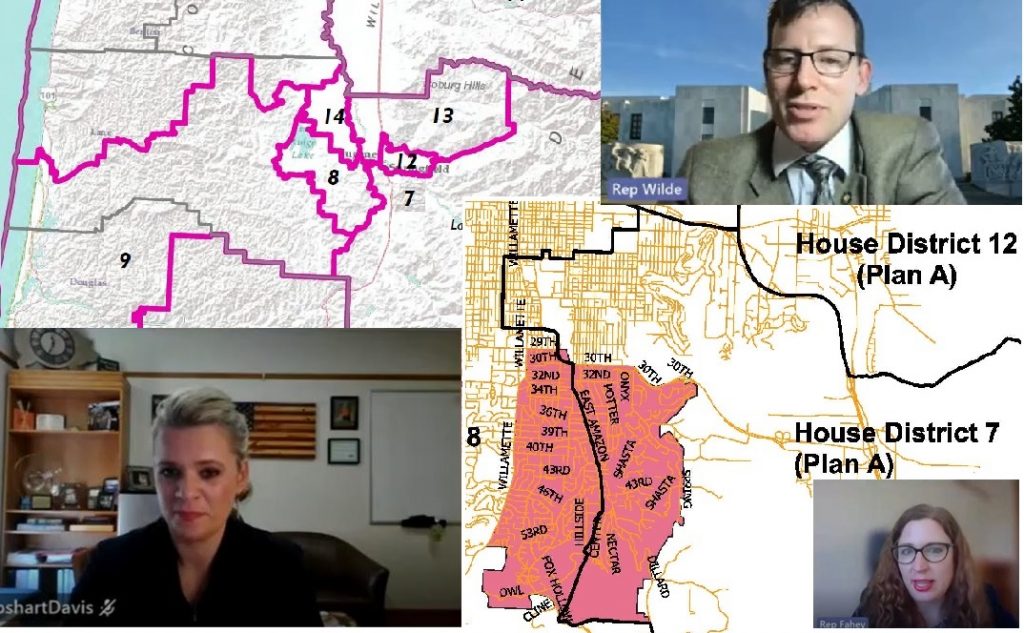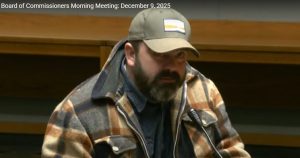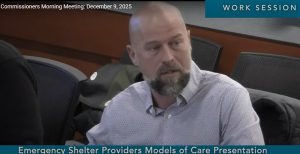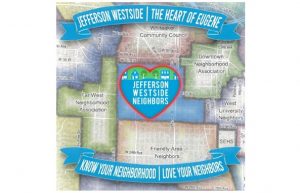Redistricting maps released for public comment; co-chair claims Eugene ‘silences rural voices’
5 min read
Redistricting maps were released for public comment Friday, Sept. 3. Rep. Shelly Boshart Davis recalled March testimony from Rep. Marty Wilde; Rep. Julie Fahey also asked that boundaries keep neighborhoods intact.
A call to keep Eugene’s neighborhoods together, as the Oregon legislature released maps of the proposed new voting districts. From the House, Representative Shelly Boshart Davis.
[00:00:12] Rep. Shelly Boshart Davis: Throughout the past year of public testimony, we have heard directly from people who don’t currently feel well-represented by partisan maps. More people are moving to our state and they deserve representation based upon their communities of interests, not the partisan advantage of any political party.
One area that generated many comments came from communities surrounding the University of Oregon. Currently we have an urban area that silences the voices of rural communities. Neighborhoods around the U of O campus are included in a predominantly rural district to determine a specific partisan outcome. We know when you pair college students with small town residents 45 miles away, to one party’s political advantage, that’s gerrymandering. These Oregonians don’t have much in common, so they shouldn’t be represented by the same person.
Testimony from their own House member agrees. Rep. Marty Wilde in March pointed out that his district crosses I-5 in two places, includes two separate parts of Springfield, and captures a small chunk of Eugene. He said we can do better.
[00:01:18] John Q: Rep. Wilde testified on March 16.
[00:01:22] Rep. Marty Wilde: We can do better in avoiding the division of communities of interest….I think we can do better.
[00:01:26] John Q: Rep. Wilde was just one of three local legislators who were hoping for better.
Thank you for supporting
local civic journalism
[00:01:33] Sen. Floyd Prozanski: My name is Floyd Prozanski, Senate District 4 is what I represent, which is large portions of Lane and Douglas county… Unfortunately, in some of those districts that were created in 2001, we saw communities that were in fact divided in half. I will give you one example, (the) Senate District that is represented by Sen. (Lee) Beyer and, and that is Pleasant Hill, Highway 58 being a natural demarcation, but of course, by splitting the districts and those who resided north of Highway 58, went into one Senate District as compared to those who were on the south side, went into a different one… We had a similar situation in the areas of Elmira and Veneta, where Territorial Road was a demarcation and in that area, I would say, it was very unfortunate, because of the smaller community being divided into two different districts at both House and Senate.
[00:02:27] Rep. Marty Wilde: My name is Marty Wilde, State Representative from House District 11. House District 11 currently covers parts of Eugene, Springfield, Creswell, Coburg, Mohawk Valley, Brownsville, Halsey, Harrisburg, and the rural areas in between…The district contains parts of cities, whole cities, two counties, and three geographically diverse regions of the Willamette valley. As currently drawn, the district certainly does not follow geographic or political boundaries.
The district also divides communities of common interests. Eugene neighborhoods are split between House districts, in the same neighborhood. It lumps two parts of Springfield that are not connected, putting an area outside downtown Springfield with the suburb of north Springfield. I appreciate that Springfield’s a community of interest and acknowledge the desirability of keeping it in HD 12 as a single district. However, HD 11 looks a lot like what’s left over when that community of interest is accommodated.
To give a few more examples, the farming communities of interest in Linn County are split between HDS 11, 15 and 17. The south valley between Cottage Grove and Eugene is split between HD 7, 8, and 11. Those current boundaries split the communities of Pleasant Hill, Cloverdale, and parts of Creswell, all of which are really arguably one community of interest in the South Willamette Valley.
While I do love the diversity of HD 11, the truth is, that it’s largely made up from geographically and politically diverse communities in order to get the right population limit, not really out of any consideration of political or geographic boundaries, community of interest, or transportation link. This patchwork ultimately does not serve the best interests of my diverse constituents. I do hope you’ll agree that HD 11 should be redrawn to better meet the requirements of the law.
I think we can do better.
[00:03:58] Rep. Julie Fahey: My name is Julie Fahey and I represent House District 14, which includes Junction City, the unincorporated community of Cheshire, but only the parts north of Highway 36, the entire neighborhood of Bethel in Eugene, and portions of the Santa Clara, River Road, Churchill and Far West neighborhoods in Eugene.
Usually I just abbreviate all of that to “West Eugene and Junction City,” but I thought it was important to spell it all out, because it helps to make one of the points I’d like to make, which is that the districts, as they exist right now in Eugene, do split up a fair number of our neighborhoods and neighborhood associations between districts. I have all of the Bethel neighborhood in House District 14, which is about 45% of the district. And I really enjoy being Bethel’s advocate in the legislature. It’s such a unique neighborhood with its own school district and its own community needs. And being the representative for Bethel means that I have the chance to really get to know and develop deep relationships with the leaders in that community. I’m also the go-to person.
And in each of the other Eugene neighborhoods I represent, I share them with another rep: Santa Clara and River Road with Rep. (Nancy) Nathanson in House District 13, and Churchill and Far West with Rep. (Paul) Holvey in House District 8. I could go on, but I will just make the point that I hope in this redistricting process, the committee will take into consideration the specific neighborhoods in Eugene and try as best you can to not split them between districts.
[00:05:19] John Q: Three proposals for the House were released on Sept. 3. Plan A would continue to divide Southeast Eugene along Amazon Creek. Plan B and Plan C would keep most of that neighborhood in one district. The public will have many opportunities to comment this month. For more, see https://OregonLegislature.gov/redistricting.



